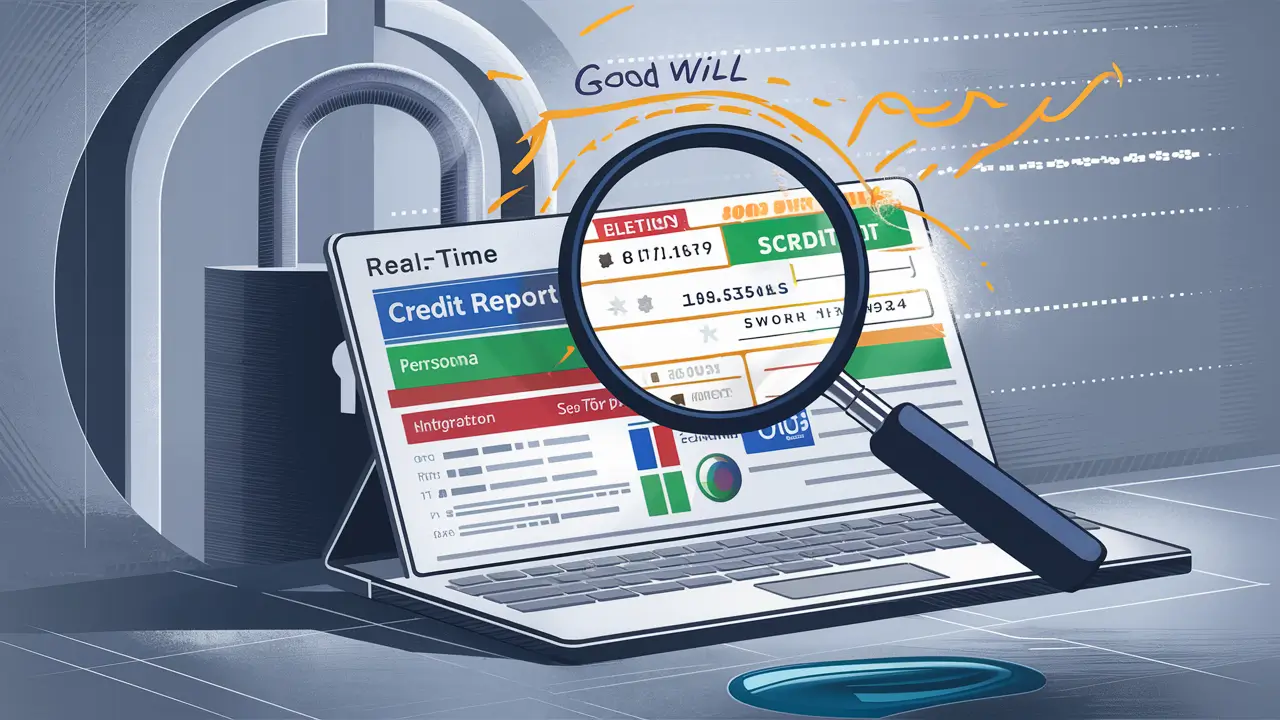-
Posted on: 26 Jul 2024

-
Your credit report is a crucial document that reflects your creditworthiness. It influences your ability to obtain loans, mortgages, credit cards, and even rent an apartment. Negative items on your credit report can significantly impact your credit score, making it harder to achieve your financial goals. While some negative entries are accurate and must remain until they naturally expire, others might be eligible for removal. One such avenue is the "good will" adjustment. This guide explores what a "good will" removal is, when it's applicable, and how to approach it.
Understanding Credit Reports and Credit Scores
Before diving into the specifics of a "good will" removal, let's recap the basics of credit reports and credit scores.
What is a Credit Report?
A credit report is a detailed record of your credit history, maintained by credit bureaus (Experian, Equifax, and TransUnion). It includes information such as:
- Your identifying information (name, address, Social Security number)
- Your credit accounts (credit cards, loans, mortgages)
- Your payment history (whether you pay on time or late)
- Public records (bankruptcies, judgments, liens)
- Credit inquiries (when lenders check your credit)
What is a Credit Score?
A credit score is a three-digit number that represents your creditworthiness, calculated based on the information in your credit report. The most common scoring model is FICO, which ranges from 300 to 850. Higher scores indicate lower risk to lenders.
Why is Credit Important?
Your credit score and credit report play a significant role in various aspects of your life, including:
- Loan approvals: Lenders use your credit to assess your risk and determine whether to approve your loan application.
- Interest rates: A better credit score typically results in lower interest rates on loans and credit cards.
- Credit card limits: Your credit score can influence the credit limit you receive on a credit card.
- Insurance premiums: Some insurance companies use credit scores to determine premiums.
- Rental applications: Landlords often check credit reports to assess the reliability of potential tenants.
- Employment: Some employers may review credit reports as part of the hiring process, especially for positions that involve financial responsibility.
What Constitutes a Negative Item on a Credit Report?
Several types of entries on your credit report can negatively affect your credit score. These include:
- Late Payments: Even one late payment can damage your score. The later the payment, the more significant the impact.
- Collections Accounts: If you fail to pay a debt, the creditor may sell it to a collection agency, which will report the account on your credit report.
- Charge-Offs: A charge-off occurs when a creditor writes off a debt as uncollectible, usually after several months of non-payment.
- Bankruptcies: Bankruptcy filings can severely damage your credit score and remain on your report for several years (7-10 years, depending on the type of bankruptcy).
- Judgments and Liens: Legal judgments and tax liens can also negatively impact your credit score.
- High Credit Utilization: Using a high percentage of your available credit can lower your score.
- Foreclosures: Foreclosure on a mortgage is a significant negative event that remains on your credit report for seven years.
The "Good Will" Removal: A Definition
A "good will" removal refers to the process of asking a creditor to remove a negative item from your credit report as an act of goodwill, even though the item is technically accurate. This strategy hinges on the idea that you have a previously good payment history with the creditor and that the negative event was an isolated incident due to extenuating circumstances.
In essence, you are appealing to the creditor's sense of fairness and hoping they will overlook a single mistake in light of your overall positive relationship. It's not a right guaranteed by law, but rather a request based on your past credit behavior.
When is a "Good Will" Removal Appropriate?
A "good will" removal is most likely to be successful under the following circumstances:
- Isolated Incident: The negative item is a one-time occurrence and doesn't reflect a pattern of poor payment behavior.
- Excellent Payment History: You have a long and positive payment history with the creditor before and after the negative event.
- Genuine Extenuating Circumstances: You can demonstrate that the late payment or other negative event was caused by unavoidable circumstances, such as job loss, medical emergency, or natural disaster.
- Timely Action: You addressed the issue promptly after the negative event occurred. For example, you caught up on late payments quickly.
- Small Debt: The amount of money involved is relatively small. Creditors may be more willing to remove a negative item for a smaller debt.
Important Note: If the negative item is due to fraud or identity theft, you should dispute it with the credit bureaus immediately, rather than requesting a "good will" removal. A "good will" request implies that the item is, in fact, accurate, while a dispute addresses inaccurate information.
How to Request a "Good Will" Removal: A Step-by-Step Guide
The key to a successful "good will" removal is to approach the creditor with a well-crafted and persuasive request.
Step 1: Identify the Specific Negative Item
Review your credit report carefully and identify the specific negative item you want to have removed. Note the creditor's name, account number, date of the negative event, and the amount involved.
Step 2: Draft a "Good Will" Letter
Your letter should be professional, polite, and persuasive. Here's a template you can adapt:
[Your Name]
[Your Address]
[Your Phone Number]
[Your Email Address]
[Date]
[Creditor Name]
[Creditor Address]
Subject: Request for Good Will Adjustment - Account Number [Account Number]
Dear [Creditor Name/Department],
I am writing to respectfully request a good will adjustment to remove a [Late Payment/Other Negative Item] reported on [Date of Negative Item] for account number [Account Number].
I have been a loyal customer of [Creditor Name] for [Number] years, and I have always made timely payments on my account. In fact, my payment history is otherwise impeccable. Prior to [Date of Negative Item], I have never been late on a payment to [Creditor Name].
The [Late Payment/Other Negative Item] was due to [Explain the extenuating circumstances that led to the negative event]. [Provide specific details. For example, "I experienced a sudden job loss and was temporarily unable to make payments. I immediately contacted [Creditor Name] to explain my situation and made arrangements to catch up on my payments as soon as I secured new employment." or "I was hospitalized for an unexpected medical emergency and was unable to manage my finances during that time. I have since recovered and am back on track with my payments."]
Since the [Late Payment/Other Negative Item], I have consistently made on-time payments and have maintained a positive relationship with [Creditor Name]. I understand the importance of maintaining a good credit score and am committed to doing so.
I understand that this is a request based on good will and that [Creditor Name] is not obligated to grant it. However, I believe that my long-standing positive relationship and the extenuating circumstances surrounding the [Late Payment/Other Negative Item] warrant your consideration. Removing this negative item would significantly improve my credit score and allow me to [Explain the positive impact, e.g., "qualify for a lower interest rate on a mortgage," "secure a new job," etc.].
Thank you for considering my request. I have attached [Supporting documentation, such as medical bills, layoff notice, etc.] to further support my claim.
I look forward to hearing from you soon.
Sincerely,
[Your Signature]
[Your Typed Name]Step 3: Gather Supporting Documentation
Include any documentation that supports your explanation of the extenuating circumstances. This might include:
- Medical bills
- Layoff notice
- Insurance claim documents
- Police report (if the issue was related to theft or fraud)
Step 4: Send the Letter
Send your letter via certified mail with return receipt requested. This provides proof that the creditor received your request.
Step 5: Follow Up
Allow the creditor a reasonable amount of time to respond (usually 30-60 days). If you haven't heard back, follow up with a phone call or another letter. Be polite and persistent, but avoid being demanding.
What if the "Good Will" Removal is Denied?
Even with a compelling letter and supporting documentation, a creditor may deny your request for a "good will" removal. If this happens, don't be discouraged. You still have other options:
- Negotiate a "Pay-for-Delete" Agreement: While controversial and not always successful, you can try to negotiate a "pay-for-delete" agreement with the creditor or collection agency. This involves offering to pay the debt in exchange for the removal of the negative item from your credit report. However, be aware that this agreement is not legally binding, and the creditor may not honor it after you pay. Get the agreement in writing before making any payments.
- Debt Validation: If you believe the debt is not valid or that the creditor lacks the proper documentation, you can request debt validation. This forces the creditor to provide proof that the debt is legitimate and that they have the legal right to collect it.
- Credit Repair Services: Consider consulting with a reputable credit repair agency. These agencies can help you identify inaccuracies on your credit report and dispute them with the credit bureaus. They can also provide guidance on improving your credit score. However, be cautious of companies that make unrealistic promises or charge exorbitant fees.
- Wait for the Item to Expire: Negative items typically remain on your credit report for 7 years (10 years for bankruptcies). While waiting may not be ideal, it's often the only option if other attempts to remove the item fail.
The Importance of Credit Monitoring
Regardless of whether you are actively pursuing credit repair, it's crucial to monitor your credit report regularly. This allows you to identify inaccuracies or fraudulent activity promptly and take steps to correct them. You can obtain a free copy of your credit report from each of the three major credit bureaus (Experian, Equifax, and TransUnion) once per year at AnnualCreditReport.com. You can also subscribe to credit monitoring services that provide ongoing access to your credit reports and alert you to any changes.
Maintaining Good Credit Habits
The best way to avoid negative items on your credit report is to practice good credit habits:
- Pay your bills on time, every time.
- Keep your credit utilization low (ideally below 30%).
- Avoid opening too many credit accounts at once.
- Check your credit report regularly for errors or fraudulent activity.











